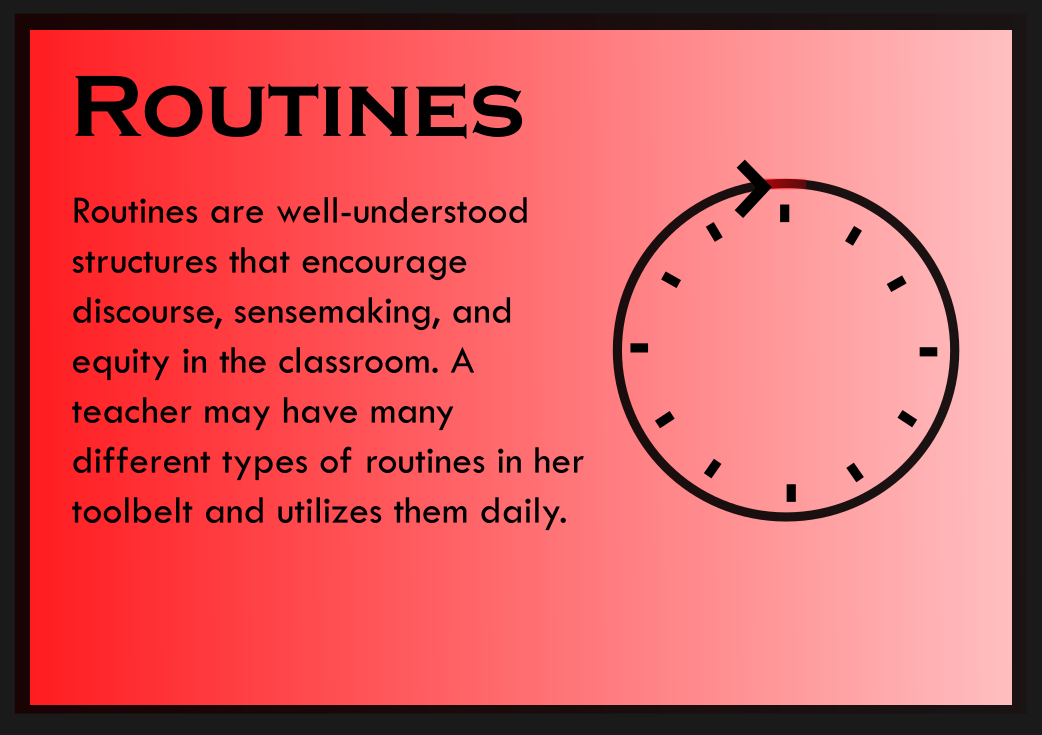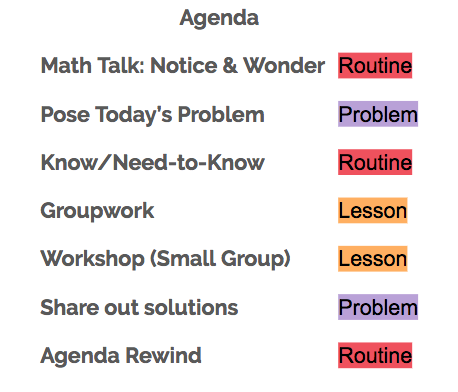This is a post in the ongoing Emergent Math mini-series: Routines, Lessons, Problems, and Projects.
If our model of Routines, Lessons, Problems, and Projects is a four-piece band, routines are our persistent drum beat. It keeps the pace going and maintains the momentum within and in between activities. Routines occur every day and throughout a class period. They help students get prepared to learn and used as learning tools themselves.

Routines become more useful with repeated use. They can be deployed for several reasons. We’ll cover four of them here: routines to help students settle in, routines for math talks, routines for problem solving, routines to promote general discourses, and routines to help close the lesson and wrap up the day.
Settling-in Routines. These are routines that help prepare students for learning. They help transition students from, say, entering your room and getting settled in at their desk. Or from the warm-up to the day’s lesson. Or to help students obtain or put away necessary supplies. There isn’t really a name for these routines, but rather a norm. In my classroom, the norm was always the following:
- Check the agenda
- Begin the warm up
I had a warm up every day (including the first day of school, the last day of school, the exam days of school, etc.) waiting for them. Sometimes they were math-content related, other times they were math-play related, and other times still they weren’t math related at all. This “routine” helped prepare their brains for maximum engagement.
Math Talk Routines. These are routines used to energize students brains around multi-faceted math problems. Many of my warm-ups allow for a math talk routine to be the first thing we do. These are excellent for estimation tasks or visual patterns.
- CTC – Contemplate then Calculate (See David Wees’ post.)
- Notice and Wonder (See Amie’s post.)
- Too big / Too small / Just right (See Andrew’s Estimation 180 handout).
Problem-Solving Routines. After posing a challenging problem – but before fully letting go and having students get to work on it – engage pupils in a routine to help them decode and identify actionable next-steps for the task at hand.
- Know / Need-to-Know (See Robert’s Problem Solving Framework template).
- George Polya’s Four step process:
- Step 1: Understand the problem.
- Step 2: Devise a plan.
- Step 3: Carry out the plan.
- Step 4: Look back.
General Discourse Encouraging Routines. These are routines you can use liberally throughout a class period when you want to encourage deeper consideration for a prompt or statement.
- Think-Pair-Share.
- Ask students to think about a problem silently (~1-2 minutes).
- Prompt students to pair up and share their thoughts with their partner. (~2-5 minutes)
- Ask students to share our their or their partner’s ideas (~5-10 minutes).
- Turn and talk.
- Don’t proceed too quickly through a demonstration or problem solution. Don’t ask for hands. Instead, ask students to briefly “turn and talk” to their neighbors to discuss what they would do next.
- “Explain her answer” (from Necessary Conditions, Krall 2018)
Teachers and students are used to the tagline of nearly every math problem ever assigned: “Explain your answer.” Leanne has an interesting twist on this prompt: “Explain his/her answer.” A student responds to a question posed by Leanne. Leanne asks another student to explain that answer and whether they agree, or if that is the tack they would have taken. This twist forces students to listen to one another while assessing the veracity of their claims.
Wrap up Routines. These are routines for when you are wrapping up the lesson or are looking to debrief the day. It’s possible you may wish to remind students of the concepts taught throughout the day or assign academic status on one another.
- Agenda Rewind
- Post the day’s agenda and ask students to place a sticky note where they had an “aha” or an additional question.
- Gallery Walk
- Ask students – or student groups – to spend 1-2 minutes at a peer’s artifact. Discuss and give feedback (optional). Rotate as a class after the allotted time to give an opportunity for everyone to see everyone else’s work (and give feedback if desired).
- Appreciations
- Ask students to publicly acknowledge a classmate who made their experience better by their presence or their actions.
You’ll likely use several different routines throughout a class period.

The more you use specific routines, the more effective they will become. Routines are especially important for Students with Special Needs as they often thrive with oft-used and reliable structures. Become nimble with routines and you’ll maximize class time and student discourse.
Ok, but how do I know if I’m doing it well?: Checking for quality
The easiest way to tell if a routine is successful is to see if every student is discussing the math. It sounds simple, but it does require some intentionality:
- Have someone observe or video your class and map the conversation. Who’s talking and what are they saying? Because we can target the video to, say, the first fifteen minutes of class, or the wrap-up, we can be judicious with our videoing. We don’t need to watch a 50-minute long video. We just need to review a 5-10 minute clip where you’re implementing or practicing a routine.
- Or use this tally-template to check for academic safety (Krall 2018).
Also in the mini-series: Routines, Lessons, Problems, and Projects: